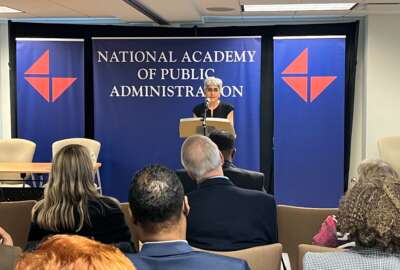
OPM must address internal skills gaps before it can effectively help other agencies
Although there has been progress toward training and hiring staff, persistent internal skills gaps pose a "significant risk" to OPM's ability to help other agencies...
“Help yourself before helping others” — it’s a familiar adage, but it’s also advice the Government Accountability Office urges the federal government’s personnel shop to take.
The Office of Personnel Management is at “significant risk” of being unable to help agencies address governmentwide skills gaps, if it can’t first do a better job of addressing its internal skills gaps, GAO said in a report published last week.
Persistent internal skills gaps “could compromise OPM’s ability to implement its strategic objectives related to closing governmentwide skills gaps,” GAO said in the Feb. 27 report.
Although OPM has made progress in some areas of workforce management, such as creating an internal committee to hire and train new staff members, the agency is struggling to clearly identify and address several skills gaps within its own staff.
Skills gaps have a broad definition — they can be competency gaps, which are a lack of staff knowledge — or staffing gaps, which are a lack of employees in a certain field. Notably, OPM has reported that there are currently three significant governmentwide skills gaps, in cybersecurity, acquisition and human resources (HR), along with 37 agency-specific ones.
But before the agency can effectively help others address those challenges, GAO said OPM needs to find a way to deal with internal issues. For example, leadership development, data analytics and project management are key areas in which OPM needs to boost skills.
Adding to the issue, OPM doesn’t have a clear “action plan” to address specific skills gaps, GAO said. Although OPM has a draft action plan, it is missing key information, like a list of mission-critical occupations and where the skills gaps are, as well as a plan to measure progress toward closing the gaps.
GAO’s findings, most notably the lack of an action plan to address identified skills deficiencies, were “concerning” to officials at the Partnership for Public Service.
“OPM is charged with ensuring the federal government is prepared for and responsive to changes in the federal workforce and workplace,” James Christian Blockwood, the Partnership’s executive vice president, said in an email to Federal News Network. “This will require OPM’s commitment to identifying skills gaps and upskilling at other federal agencies, as well as its own workforce.”
OPM Chief Human Capital Office Carmen Garcia, though, said in a Feb. 10 letter to GAO that OPM is already taking steps to address skills gaps, including through using shared certificates, expanding the use of non-competitive hiring authorities to reach early-career employees and adding more positions that are eligible for remote work.
It is also notable that OPM has faced significant challenges in just the past several of years. Although OPM’s challenges are more long-term, the proposed merger of OPM with the General Services Administration during the Trump administration caused staff turnover. Efforts to rebuild the workforce afterward compounded with OPM’s ability to effectively address skills gaps.
“OPM is still recovering from the failed attempt by the previous administration to pull it apart and place its authorities in other agencies,” Dan Blair, former OPM deputy director, said in an interview with Federal News Network. “The proposed shutdown took its toll in terms of employee morale, recruitment and retention. It should be of no surprise that GAO recommended that OPM analyze its own skills gaps and capacity if it is to carry out its governmentwide mission successfully.
Additionally, OPM lacked permanent leadership for two years, prior to the confirmation of current OPM Director Kiran Ahuja, which led to additional workforce challenges.
“Unfortunately, stable leadership at OPM had been an issue for some time,” Blockwood said. “A Senate-confirmed OPM director has not served a full four-year term since 2013 … This leadership void had a ripple effect across government.”
But GAO said there have been recent improvements for human capital, in part because it’s a top priority in the Biden administration’s President’s Management Agenda (PMA). Additionally, OPM has improved collaboration within the Chief Human Capital Officers (CHCO) Council. There has also been OPM guidance to agencies on skills-based hiring, as well as a relatively new remote work filter on USA Jobs.
Even with these improvements, OPM’s current internal skills gaps lead to challenges with implementing some of the agency’s broader strategic objectives, GAO said.
“OPM did not list its skills gaps as a risk to implementing its strategic objectives, an essential element of enterprise risk management,” GAO said in the report. “Doing so would better position OPM to have the near- and long-term capacity to help other agencies close skills gaps across the federal government.”
Ron Sanders, former chairman of the Federal Salary Council and former associate director for HR policy at OPM, said the results of the GAO report were “unsurprising,” but that the reason behind the challenges may be difficult to measure.
“I think the skills gaps and have more to do with intangibles than they do with specific functional specializations,” Sanders, current president and CEO of Publica Virtu LLC, said in an interview with Federal News Network. “So much of this comes down to leadership.”
“If the leadership doesn’t make it a priority, then these things won’t happen,” Blair added. “It needs to have support, not just within the agency, but also across the board. The CHCO Council needs to be able to support and work on this.”
Notably, poor workforce management, along with low staffing and inadequate training, are some of GAO’s rationales for keeping strategic human capital management on its high-risk list, where it has remained since 2001. Issues with leadership continuity and succession planning additionally contribute to challenges with strategic human capital management.
OPM’s internal skills gaps also dovetail with growing challenges for human capital management governmentwide. For the report, GAO surveyed agency CHCOs to get a broader sense of federal HR issues.
Federal human capital leaders who participated in GAO’s forum last May said recruitment and workforce planning were the two biggest pain points when trying to close skills gaps. Many of the participants said OPM should offer more workplace flexibilities and streamline guidance to help reduce administrative burdens on staff.
Agency leaders added that generally, competition with the private sector, budget uncertainty and differences in compensation made it more difficult to try to close skills gaps. Special salary rates can help some agencies recruit and retain workforce for particular skills, but that could leave other agencies without those flexibilities with heightened challenges.
Many of the human capital changes that agencies currently make are specific to the individual agency, such as the Department of Homeland Security’s cyber talent management system. But OPM is still positioned to target governmentwide reform, Sanders said.
“In my view, we passed an inflection point more than a decade ago, with the bulk of civil service reforms now taking place at an agency level. They’re not sweeping governmentwide reforms, and yet OPM is still geared for the latter,” Sanders said. “Agency-specific personnel flexibilities are going to be the wave of the future. Nobody is holding their breath for governmentwide reform.”
Adding to the difficulties, OPM’s workforce is very “insular,” Sanders said, meaning there is not a lot of understanding between the governmentwide HR agency, and the agencies that OPM is intended to support.
But there are ways to improve collaboration, that may not require additional resources or funding. Sanders recommended, for instance, that OPM should require candidates for management positions to have experience in another agency’s HR department, and on the flipside, those applying for agency CHCO positions should have prior experience working at OPM.
“OPM is in the process of running out of time,” Sanders said. “This would send a huge signal to everybody that they’re serious about this.”
To try to close skills gaps, GAO recommended that OPM create an “action plan,” which the agency has agreed to do. In response to the initial GAO report, OPM said it plans to conduct a “human capital review” this spring.
“OPM will develop and implement an action plan to address our agency-specific skills and competency gaps via selected human capital strategies,” OPM’s CHCO Garcia told GAO.
But beyond creating the action plan, Sanders said it will be equally important, if not more so, to look at the actual execution of it.
“You can make your pronouncements tomorrow,” he said. “Then execution may take some time. But the action plan needs both [policy and execution].”
Much of that action plan should also consider emerging skills gaps. Blair said beyond closing current skills gaps, it’s important for OPM to plan for what may appear several years in the future, then try to mitigate potential gaps before they appear.
“It’s about looking in the crystal ball and trying to predict what might be happening in the future,” he said. “If you don’t prepare for future problems, then they arise. At least this way, you can get a little bit ahead of the curve.”
GAO additionally recommended that OPM document and monitor progress for addressing the risks that skills gaps create.
“Until OPM documents risks to its strategic objectives posed by skills gaps and identifies risk responses, OPM may not be making fully informed budgetary, operational and other trade-off decisions or best positioning itself to have the near- and long-term capacity to help other agencies close skills gaps across the federal government,” GAO said.
The House Oversight and Accountability Committee will hold a hearing Thursday to examine OPM’s administration of federal human capital policy, as well as OPM’s plans to strengthen the merit-based civil service system.
Copyright © 2025 Federal News Network. All rights reserved. This website is not intended for users located within the European Economic Area.
Drew Friedman is a workforce, pay and benefits reporter for Federal News Network.
Follow @dfriedmanWFED





